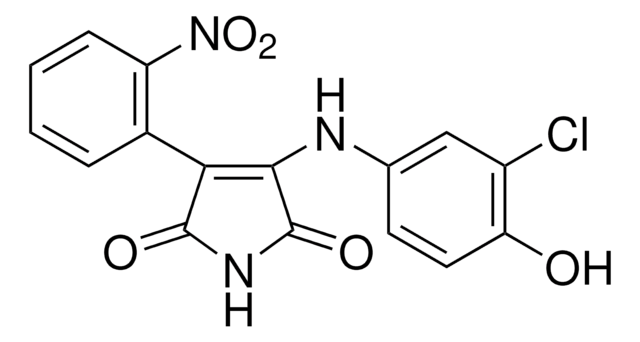K3888
Kenpaullone
≥98%
Synonym(s):
9-Bromo-7,12-dihydro-indolo[3,2-d][1]benzazepin-6(5H)-one, NSC 664704
About This Item
Recommended Products
Assay
≥98%
form
solid
color
yellow
solubility
DMSO: 18 mg/mL, clear, yellow
storage temp.
2-8°C
SMILES string
Brc1ccc2[nH]c-3c(CC(=O)Nc4ccccc-34)c2c1
InChI
1S/C16H11BrN2O/c17-9-5-6-14-11(7-9)12-8-15(20)18-13-4-2-1-3-10(13)16(12)19-14/h1-7,19H,8H2,(H,18,20)
InChI key
QQUXFYAWXPMDOE-UHFFFAOYSA-N
Gene Information
human ... CDC2(983)
mouse ... Gsk3b(56637)
rat ... Gsk3b(84027)
Application
- as a glycogen synthase kinase 3 (GSK3)/ cyclin-dependent kinase (CDK) inhibitor to study its effects on human neural progenitor cell lines
- as an inhibitor of Krupple-like factor 4 (KLF4) in Gs-coupled designer GPCR (Gs DREADD= GsD) Agouti-related peptide (GsD-AgRP) mice
- as a GSK3/CDK inhibitor to study its effects on the sea urchin embryo development
Biochem/physiol Actions
Features and Benefits
Packaging
Storage Class Code
11 - Combustible Solids
WGK
WGK 3
Personal Protective Equipment
Certificates of Analysis (COA)
Search for Certificates of Analysis (COA) by entering the products Lot/Batch Number. Lot and Batch Numbers can be found on a product’s label following the words ‘Lot’ or ‘Batch’.
Already Own This Product?
Find documentation for the products that you have recently purchased in the Document Library.
Customers Also Viewed
Our team of scientists has experience in all areas of research including Life Science, Material Science, Chemical Synthesis, Chromatography, Analytical and many others.
Contact Technical Service








